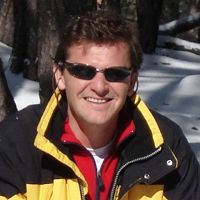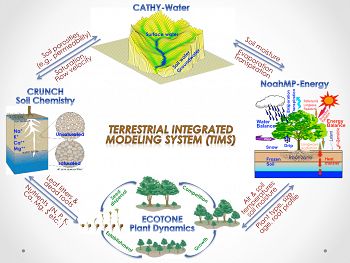Niu et al., 2014
A Terrestrial Integrated Modeling System (TIMS) at a catchment scale – implications for Earth System Modeling
Niu G-Y., Fang Y., Wu R., Mathias A., Paniconi C., Troch P., Zeng X., Chorover J., Monson R. (2014)
Abstract H53J-05 presented at 2014 Fall Meeting, AGU, San Francisco, CA, 15-19 Dec.
-
Catalina-Jemez, INVESTIGATOR, COLLABORATOR
-
Catalina-Jemez, INVESTIGATOR
-
Catalina-Jemez, INVESTIGATOR
Abstract
To enhance our predictive understandings of the interactions between the soil, plants, and air and their integrated behavior at hillslope and catchment scales, we have been developing a Terrestrial Integrated Modeling System (TIMS). TIMS aims to numerically simulate various physical and chemical processes that occur over the Earth’s terrestrial surface, e.g., exchanges and flows of energy, water, carbon and other chemicals between and within the soil, plants, and air. TIMS is being compiled from existing models that have arisen from individual scientific communities, including 1) a surface energy, water, and carbon exchange scheme (NoahMP), 2) a 3-dimensional physically-based hydrological model (CATHY), 3) a reactive transport model (CrunchFlow), and 4) an individual-based vegetation dynamics model (ECOTONE). TIMS also integrates newly developed components, e.g., a microbial enzyme based soil organic carbon decomposition model and a solar radiation correction scheme accounting for the effects of terrain shading and slope angle and aspect. We will present the current state of TIMS development and some validations against measurements at various scales, the challenges for developing and evaluating such a complex modeling system, and implications for scaling-up plot-scale processes (e.g., AmeriFlux) to global-scale land surface models for use in Earth System Models (ESMs).
Citation
Niu G-Y., Fang Y., Wu R., Mathias A., Paniconi C., Troch P., Zeng X., Chorover J., Monson R. (2014): A Terrestrial Integrated Modeling System (TIMS) at a catchment scale – implications for Earth System Modeling. Abstract H53J-05 presented at 2014 Fall Meeting, AGU, San Francisco, CA, 15-19 Dec..
 This Paper/Book acknowledges NSF CZO grant support.
This Paper/Book acknowledges NSF CZO grant support.
Explore Further




